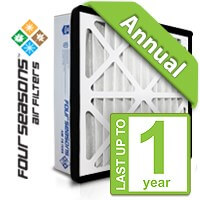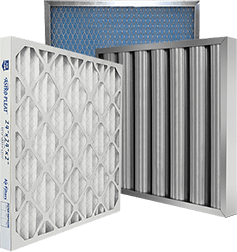A Guide to Indoor Air Quality and How to Improve It
The United States Environmental Protection Agency (EPA) defines Indoor Air Quality (IAQ) as the air quality within and around buildings and structures, especially as it relates to the health and comfort of building occupants. Understanding and controlling common pollutants indoors can help reduce your risk of indoor health concerns. Health effects from indoor air pollutants may be experienced soon after exposure or, possibly, years later.
Air Quality Standards
The Clean Air Act requires the EPA to set National Ambient Air Quality Standards (NAAQS) for pollutants that are common in outdoor air, considered harmful to public health and the environment, and that come from varying sources.The EPA has set standards for six principal pollutants, which the EPA refers to as “criteria” air pollutants.The Clean Air Act identifies two types of national ambient air quality standards:
- Primary standards provide public health protection, including protecting the health of "sensitive" populations such as asthmatics, children, and the elderly.
- Secondary standards provide public welfare protection, including protection against decreased visibility and damage to animals, crops, vegetation, and buildings.
Resource:
epa.gov
What Affects Indoor Air Quality?
Indoor air quality is affected by a variety of both indoor and outdoor pollutants. Below are common pollutants that affect your overall IAQ:
- Household cleaners
- Waxes and Polishes
- Disinfectants and Sanitizers
- Air Fresheners
- Tobacco Products and Smoke
- Glues and Adhesives
- Dirty Mops
- Drain Cleaners and Clog Removers
- Vacuuming
- Paints and Primers
- Pet Dander
- Pesticides
- Dirt and Dust
- Pollen
Impacts of Poor Air Quality
The impacts of poor air quality can produce both acute and chronic health effects.
Acute Effects are those that follow immediately after exposure to airborne contaminants in poor IAQ environments (within 24 hours), including:.
- Headaches
- Itchy Eyes
- Dizziness
- Runny Nose
- Asthma
Chronic Effects are long-lasting effects to frequent or extended exposure to poor or dangerous indoor air quality conditions, including:
- Chronic Headaches
- Cancer
- Upper Respiratory Diseases
- Heart Disease
- Asthma
Recognizing Poor Air Quaity
When recognizing if you have poor air quality, it is important to pay attention to family members and other occupants to see if they frequently experience sneezing, headaches, coughing, itchy and watery eyes. We often assume these symptoms are related to seasonal/weather changes or allergies but if you see that these symptoms arise only when entering the home, this could be a sign of poor IAQ. Today we spend over 90% of our time indoors where the air is often more polluted than the air outside. This is caused by household cleaners, dirt, dust, and other airborne contaminants that get trapped and recycled in our tightly sealed homes and buildings.
Common Signs of Poor Air Quaity
- Dryness or irritation of the eyes, nose, throat, and skin
- Headaches and migraines
- Fatigue
- Allergies
- Sinus Congestion
- Coughing and Sneezing
Air Quality Tests
Indoor Air Quality Monitor
Indoor air quality often gets forgotten in the chaos of our day to day lives but is vital to ensuring everyone in your home is healthy. The best way to truly test the quality of your indoor air is to invest in an indoor air quality monitor. An indoor air quality monitor is a device that consistently tests and logs the level of pollutants and contaminants inside your home. These devices typically check for PM2.5 levels (small dust and dirt particles and other common allergens that can found in the air), VOCs (Volatile Organic Compounds –chemical pollutants), temperature, and humidity (mold/mildew). These devices typically range from $150-$250.
Carbon Monoxide Device
Another, important device to have in your home to help ensure you have a safe IAQ is a carbon monoxide alarm. This device detects carbon monoxide gas, which is commonly known as the “silent killer”. Carbon monoxide is an odorless, colorless and tasteless gas that is a byproduct of many gas operating appliances including stoves, fireplaces, furnaces, hot water heaters, and grills. Even if you don’t have a gas operating stove or dryer it is recommended to install one in your home just as a precaution. Because carbon monoxide is lighter than air, it is recommended to install the detector on or close the ceiling so that you can be alerted if there are high levels of CO in your home.
Radon Testing
Radon is naturally occurring radioactive gas that like carbon monoxide, that you can’t see or smell. Radon occurs naturally during the decay of elements like uranium and radium commonly found in rocks and soil. When breathed in this radioactive gas can damage the cells lining your lungs. Exposure to high levels of radon over an extended period can lead to an increased risk of lung cancer development. Many radon tests can be found at your local hardware store. Follow the instructions on the test’s packaging to ensure proper placement for testing and where to send test once completed to find out your radon level.
4 Steps to Improve Air Quality
Having poor indoor air quality in your home can significantly affect the wellbeing of you, your family and other occupants. Below are a few simple solutions to help keep your indoor air clean and healthy!
1. Open Doors and Windows
Airing out your home regularly by opening doors and windows allows for fresh air to cycle throughout your home. Leave windows/doors open for at least 10 min to purge your home of unhealthy air. Even in cities the outdoor air is cleaner than indoor air, so don’t be afraid to air out your house; apartment occupants can do this too!
2. Replace Chemical Cleaning Supplies with Toxin Free Cleaners
Many common household cleaners use chemicals that release VOCs (volatile organic compounds) which can be dangerous to your health. Switching out your cleaning supplies with natural products is a simple way to improve your IAQ.
3. Use an Air Purifier
Air Purifier devices remove air contaminants in order to improve overall air quality.
4. Add Live Foliage to your Decor
Adding live plants throughout your home or office space can improve your indoor air quality. Many household plants are effective at absorbing and processing gases and chemicals like benzene, formaldehyde, carbon monoxide, and Volatile Organic Compounds (VOCs) that are commonly found in homes and offices. Below are some recommended indoor plants that help improve your IAQ.
The Role of Air Filters in Air Quality
With people spending increasingly large amounts of their time indoors (about 90%), it is critical that our indoor air is clean and safe. Air filters help rid the air of contaminants that are commonly found in homes including dust, dirt, fibers, dust mites, smoke, pet dander, pollen, and mold spores. When air passes through the filter these pollutants are captured and stopped by the filter media allowing only fresh healthy air to recirculate through your home.
Product Highlight
Want to save money AND time by only having to change your filter as little as once a year? Upgrade your 1” filter to our 4” FourSeasons filter that is specially designed to fit into your existing 1” opening/air return. No tools or modifications needed.
FOUR SEASONS™ FILTER MEDIA
Utilizing electrostatically charged, 100% synthetic media, our annual air filters offer significantly higher particulate efficiency than standard fiberglass or pleated filters, with little change in static pressure. The FourSeason’s filter media will not promote the growth of bacteria, mold, mildew, or fungi in normal operating environments, and has not been chemically treated. The Four Seasons™ 4” pleated filters are an ideal upgrade from standard disposable/fiberglass filters. The FourSeaon filters are designed to last up to 6-12 months depending on the environment.

Customize Your Air Filter in 4 Easy Steps
APPLICATION

EFFICIENCY

DIMENSIONS

DELIVERY


Air Filters, Inc. is committed to providing a "one-stop shop" for all of your air filtration requirements. As an air filter manufacturer, we are uniquely positioned to custom make any and all types of air filters.
build your custom filter now
Have a Question?
Send us a message below or call us at 1.800.667.8563
Resources
-
Track My Order
Ordered your filters and need to know where they are?
-
Careers
Want to work for Air Filters Inc.? We are hiring!
-
Glossary
Browse a full list of industry terms to better choose your filters.
-
Download Catalog
Receive our full product catalog via email.
-
Affiliates
View all of our Company Brands.
-
Video Library
Need to know how to install your filters? Watch helpful videos from AFI.






